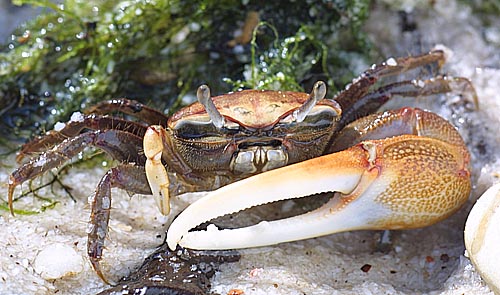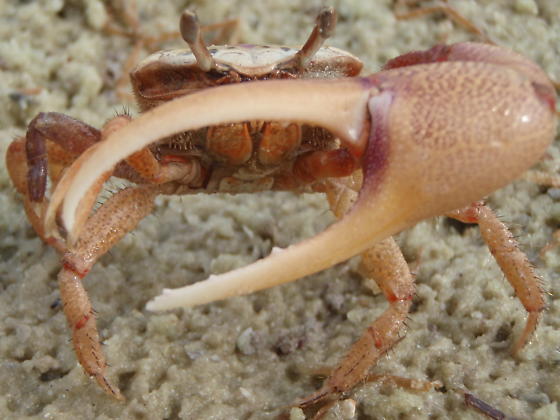
Florida beaches and marshlands are home to three species of fiddler crab, the sand fiddler (Uca pugilator), the mud fiddler (Uca pugnax) and the red-jointed or brackish water fiddler (Uca minax), in the order Decopoda – meaning 10-legs. Two of these “legs” – the front ones – are adapted as claws, however. The males are easily identified by their one oversized front claw, which can weigh up to one-third of the crab’s total. Accounts differ as to the origin of the name, “fiddler.” One explanation claims the name came from the use these crabs make of their smaller front claw to eat. The motion of picking up its food, depositing it in its mouth, and placing discarded bits back on the ground resembles the bow action of a fiddler. The male’s one outsized claw is useless for that purpose; he eats (or fiddles with his food) one-handed, while the female is free to gobble her meal with both hands.
The adult fidder’s notion of “food” includes the algae, bacteria, fungus, and decaying matter in sand, which the crab picks up with the “eating claw”. Edible material is separated from sand in the mouth; the discarded “sandballs” are deposited back on the ground. Because of this diet, fiddlers are important as regulators of bacteria and fungus in beach and marsh. The tunnels they dig in the intertidal zones and mud flats provide them with shelter when the tides rise and also aerate the ground, further ensuring the health of those soils.
With such a large claw, you’d think that the male fiddler would be an aggressive fighter, but not so. That large claw is better adapted to waving than fighting. One male waves it at another potentially threatening male to intimidate it; this waving seldom progresses to the fighting stage. The larger the claw and the more vigorous the wave, the better the chance of intimidating one’s opponent. If the crabs do engage in physical combat, the vanquished crab risks losing that precious claw and having to regrow another, which never reaches the size of the first.
Resources


